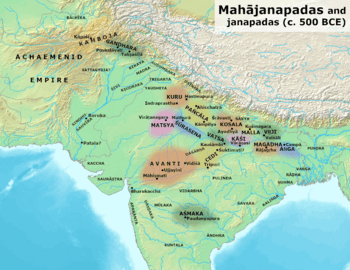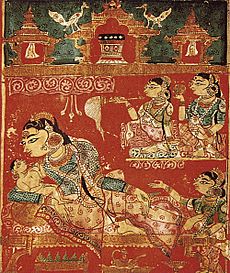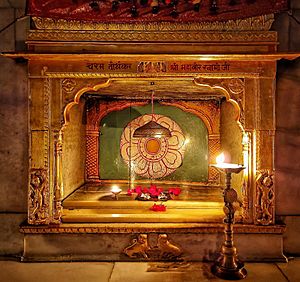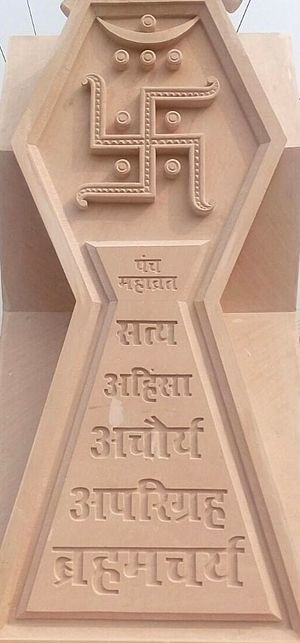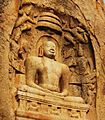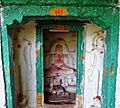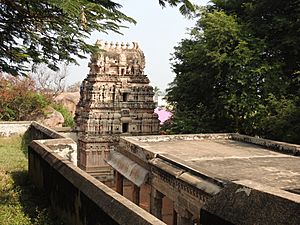Mahavira facts for kids
Quick facts for kids Mahavira |
|
|---|---|
| 24th Jain Tirthankar | |
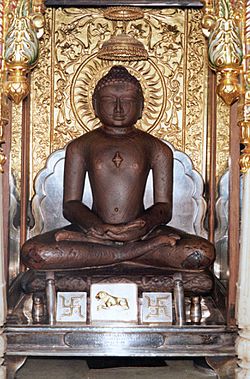
The famous idol of Mahavir at Shri Mahavirji
|
|
| Other names | Vira, Ativir, Vardhaman, Sanmati, Nayaputt, Kashyap, Keval |
| Venerated in | Jainism |
| Predecessor | Parshvanatha |
| Symbol | Lion |
| Age | 72 years |
| Tree | Shala |
| Complexion | Golden |
| Personal information | |
| Born | c. 599 BCE Kshatriyakund, Vaishali, Vajji (present-day Vaishali district, Bihar, India) |
| Died | c. 527 BCE or 425 BCE (aged 71–72)Pawapuri, Magadha (present-day Nalanda district, Bihar, India) |
| Parents |
|
| Siblings |
|
Mahavira (meaning "Great Hero") was the 24th and last tirthankara (a great spiritual teacher) of Jainism. He was the spiritual leader after the 23rd tirthankara, Parshvanatha. Mahavira was born around 599 BCE into a royal family in ancient India. His mother was Trishala and his father was Siddhartha. They were followers of Parshvanatha.
At about 30 years old, Mahavira left his home and royal life. He wanted to find spiritual awakening and became an ascetic (someone who lives a simple life without comforts). He meditated deeply and practiced severe self-control for twelve and a half years. After this, he reached Kevala Jnana (perfect knowledge or omniscience). He taught for 30 years and achieved Moksha (freedom from rebirth) around 527 BCE.
Mahavira lived at the same time as Gautama Buddha, who founded Buddhism. Jains celebrate Mahavira's birthday, called Mahavir Janma Kalyanak, every year in March or April.
Mahavira taught that certain vows are important for spiritual freedom. These include ahimsa (non-violence), satya (truth), asteya (not stealing), brahmacharya (purity), and aparigraha (not being attached to things). He also taught about Anekantavada, which means reality has many sides. His teachings were written down by his main student, Indrabhuti Gautama, in texts called the Jain Agamas.
Mahavira is often shown sitting or standing in a meditative pose. A lion symbol is usually placed below him. His earliest images were found in Mathura, India, and date back to the 1st century BCE. Jains celebrate his birth as Mahavir Janma Kalyanak. His nirvana (death) is celebrated as Diwali by Jains.
Contents
Names and Titles
Early Jain and Buddhist writings use several names for Mahavira. These include Nayaputta, Muni, Samana, Niggantha, Brahman, and Bhagavan. In early Buddhist texts, he is called Araha (meaning "worthy") and Veyavi (meaning "wise").
Later Jain texts say his childhood name was Vardhamāna. This means "the one who grows," because his kingdom became very rich when he was born. He was called Mahavira ("the great hero") by gods because he stayed strong through dangers and hardships. He is also known as a tirthankara, which means a "ford-maker" or "savior."
Mahavira's Life Story
Most scholars agree that Mahavira lived in ancient India. Jain texts say he was born in Kundalpur or Kundagrama, which is now in Bihar, India. He gave up his wealth and left home when he was around 28 or 30. He lived a very strict life for over twelve years. After this, he gained perfect knowledge and then taught Jainism for thirty years.
Mahavira was born in 599 BCE and passed away in 527 BCE. The place where he achieved nirvana, Pawapuri in Bihar, is a very important pilgrimage site for Jains.
Jain Traditions About Mahavira
According to Jain beliefs, 24 Tirthankaras have appeared on Earth. Mahavira is the last tirthankara of the current time cycle. A tirthankara helps people cross the "sea" of rebirth cycles.
His Birth
Mahavira was born into a royal family. His father was King Siddhartha and his mother was Queen Trishala. They belonged to the Ikshvaku Dynasty. Jains believe Mahavira was born in 599 BCE. His birthday, Mahavir Janma Kalyanak, is celebrated in March or April.
Jain texts say that after Mahavira was born, the god Indra came from the heavens. Indra anointed him and performed a special ceremony on Mount Meru. These events are shown in many Jain temples and are part of modern Jain rituals.
Early Life
Mahavira grew up as a prince. His parents were followers of Parshvanatha. Jain traditions have different stories about whether Mahavira married. The Digambara tradition believes he did not marry. The Śvētāmbara tradition believes he married Yashoda and had a daughter named Priyadarshana.
Jain texts describe Mahavira as being tall, about 6 feet. He was the shortest of the 24 tirthankaras. Earlier arihants (perfected beings) were believed to be much taller.
Giving Up Worldly Life
At age thirty, Mahavira left his royal life, home, and family. He wanted to find spiritual awakening. He fasted strictly and meditated under an Ashoka tree. The Acharanga Sutra describes the difficulties he faced and his self-control. Mahavira spent many monsoon seasons in different places during his ascetic life.
Perfect Knowledge
Mahavira achieved Kevala Jnana (perfect knowledge) when he was 43 years old. This happened under a Sāla tree near the River Rijubalika. He had practiced strict penance for twelve years. Jains believe Mahavira could see and know everything. After gaining perfect knowledge, he taught his philosophy for thirty years.
His Students
Jain texts mention eleven Brahmins as Mahavira's first students. They are known as the eleven Ganadharas. Indrabhuti Gautama was their leader. These Ganadharas are believed to have remembered and shared Mahavira's teachings after he passed away. His teachings became known as the Jain Agamas.
According to the Kalpa Sutra, Mahavira had many followers. These included 14,000 male ascetics, 36,000 female ascetics, 159,000 male lay followers, and 318,000 female lay followers. Mahavira taught his followers the mahavratas (Five Vows).
Nirvana and Moksha
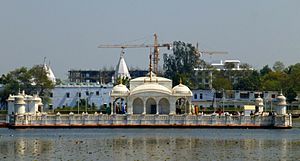
Jain texts say Mahavira's nirvana (death) happened in Pawapuri, Bihar. Jains celebrate his nirvana and the night he became a spiritual light as Diwali. This is the same time Hindus celebrate Diwali. His main student, Gautama, is said to have gained perfect knowledge the night Mahavira achieved nirvana.
The stories of Mahavira's nirvana vary. Some describe a simple passing, while others tell of grand celebrations with gods and kings. Some texts say that only his nails and hair were left behind, and his body dissolved like camphor. Jains believe Mahavira achieved nirvana in 527 BCE. His soul is believed to live in Siddhashila, the home of liberated souls. The Jal Mandir in Pawapuri marks the spot where he is said to have achieved moksha.
Previous Lives
Jain texts describe Mahavira's many previous lives before his birth as a tirthankara. A soul goes through countless rebirths. The birth of a tirthankara is special. Jain texts say Mahavira had 26 births before his last one. These included being a lion and a god.
Teachings of Mahavira
Early scholars sometimes thought Jainism was a part of Buddhism. However, as more was learned, it became clear that Mahavira's teachings were very different from Buddha's. Mahavira taught about the soul, which Buddhists did not. His focus on ahimsa (non-violence) was also much stronger than in other Indian religions.
Jain Agamas
Mahavira's teachings were put together by his chief student, Gautama Swami. These sacred texts are called the Jain Agamas. Over time, some of Mahavira's teachings were lost. Later monks tried to gather and write them down again. This led to some differences between the Svetambara and Digambara Jain traditions. The texts were first written on palm-leaf manuscripts.
Five Vows
The Jain Agamas list five important vows that followers must keep. Mahavira taught these ethical rules:
- Ahimsa (Non-violence): Mahavira taught that every living being is important and should be respected. This vow applies to actions, speech, and thoughts.
- Satya (Truthfulness): Being truthful to oneself and others.
- Asteya (Non-stealing): Not taking anything that has not been given.
- Brahmacharya (Purity): Being pure in thought and action.
- Aparigraha (Non-attachment): Not being too attached to possessions or worldly things.
The goal of these rules is to find spiritual peace and eventually freedom from rebirth. Mahavira is best known for teaching that ahimsa is the most important moral value. He taught that harming any living being creates bad karma. This karma affects one's future lives and suffering.
The Soul
Mahavira taught that the soul exists. This idea is shared with Hinduism but not Buddhism. Mahavira believed the soul is eternal but also changes.
For Mahavira, the universe has dravya (substances), jiva (living souls), and ajiva (non-living things). The jiva (soul) is tied to saṃsāra (the cycle of rebirth) because of karma. Karma in Jainism includes actions and intentions. It affects how, where, and as what a soul is reborn.
Mahavira taught that there is no creator god. Existence has no beginning or end. Gods and demons exist in Jainism, but their souls are also part of the same cycle of birth and death. The goal of spiritual practice is to free the soul from karma. This allows it to enter the realm of the siddhas, which are souls free from rebirth. Mahavira believed that enlightenment comes from self-improvement and self-control.
=Anekantavada
Mahavira taught the idea of Anekantavada (many-sided reality). This means that truth and reality are complex and have many parts. Reality can be experienced, but it's hard to explain it fully with words alone. Human attempts to describe truth are only "partial expressions." Language itself is not the truth, but a way to express it.
Mahavira's anekantavada teaching is also mentioned in Buddhist texts. It is a key difference between his teachings and those of the Buddha. The Buddha taught a "Middle Way," avoiding extremes. Mahavira accepted both "it is" and "it is not," with the idea of "perhaps" or "in some respect."
This doctrine has been seen by some as promoting religious tolerance. However, it is mainly about the nature of reality, not about accepting all religious views as equally right. For example, the five vows for Jain monks are very strict, with no "perhaps" about them.
Gender Equality
Jainism has had different views on whether women can achieve spiritual freedom. The Digambara sect believed that women cannot fully practice asceticism and achieve spiritual freedom in their current form. They thought a woman could only achieve it by being reborn as a man.
However, Mahavira taught about equality between men and women. The Svetambara tradition believes that Mahavira encouraged both men and women to live an ascetic life. They believe both sexes can achieve moksha (spiritual freedom).
Rebirth and Realms
Rebirth and different realms of existence are core teachings of Mahavira. According to the Acaranga Sutra, Mahavira believed that life exists in many forms. These include animals, plants, insects, water, fire, and wind. He taught that monks should avoid harming any of these beings.
Mahavira taught that existence is a cycle. The soul is reborn after death in one of three realms: heavenly, hellish, or earthly. Humans are reborn based on their karma (actions). They can be reborn as a human, animal, plant, or other form. Nothing is permanent; everyone dies and is reborn. Jinas who have reached perfect knowledge are not reborn. They enter the siddhaloka, the "realm of the perfected ones."
Mahavira's Impact
His Lineage
Mahavira is sometimes mistakenly called the founder of Jainism. However, Jains believe that 23 tirthankaras came before him. Mahavira is seen as the spiritual successor to Parshvanatha. Parshvanatha lived about 273 years before Mahavira. Jain texts suggest Mahavira's parents were followers of Parshvanatha. When Mahavira revived the Jain community, ahimsa was already a strict rule.
Jains believe that Parshvanatha's teachings influenced Mahavira. Parshvanatha is a very popular figure in Jain temples. Of the 24 tirthankaras, Mahavira and Parshvanatha are most often shown in Jain art.
Festivals
Two main Jain festivals are linked to Mahavira: Mahavir Janma Kalyanak and Diwali. During Mahavir Janma Kalyanak, Jains celebrate Mahavira's birth as the 24th tirthankara. Diwali remembers the anniversary of Mahavira's nirvana. Jains celebrate it at the same time as the Hindu festival of Diwali. For Jains, Diwali marks the New Year.
Worship
Mahavira is one of the five tirthankaras most worshipped by Jains. Many Jain temples across India are dedicated to him. These temples are important pilgrimage sites. For example, Pawapuri is a hilly area in Bihar. It is believed that 23 of the 24 tirthankaras preached there. The Mahavira Jain temple, Osian in Rajasthan is one of the oldest Jain temples in western India.
Influence
Mahavira's teachings were very influential. Rabindranath Tagore said that Mahavira showed that religion is a true way of life, not just a social custom. He taught that true freedom cannot be found by only doing outer ceremonies.
In 1974, for the 2,500th anniversary of Mahavira's nirvana, something special happened. For the first time, Jain monks from different groups came together. They agreed on a common flag and symbol. They also worked to unite the Jain community.
Iconography
Mahavira is usually shown sitting or standing in a meditative pose. A lion symbol is placed below him. Each tirthankara has a special symbol to help people identify their idols. Mahavira's lion symbol is usually carved below his legs. Like all tirthankaras, he has a Shrivatsa mark on his chest. This mark helps identify Jain statues.
The earliest images of Mahavira are from Mathura, India, dating from the 1st century BCE to the 2nd century CE. Differences in how Digambara and Svetambara traditions show Mahavira appeared later, around the 5th century CE. Many images of Mahavira have been found from the 12th century and earlier.
Jivantasvami shows Mahavira as a prince. In this form, he stands in a special pose called kayotsarga, wearing a crown and ornaments.
Images for kids
-
Rock-cut sculpture of Mahavira in Samanar Hills, Madurai, Tamil Nadu
-
Four-sided sculpture of Mahavira in Kankali Tila, Mathura
-
Relief of Mahavira in Thirakoil, Tamil Nadu
-
16-foot, 2-inch stone statue of Mahavira in Ahinsa Sthal, Mehrauli, New Delhi
-
Mahavira statue in Cave 32 of the Ellora Caves
Temples
Along with Rishabhanatha, Parshvanatha, Neminath, and Shantinath, Mahavira is one of the five tirthankaras most worshipped by Jains. Many Jain temple complexes across India feature him. These are important pilgrimage sites. Pawapuri, for example, is a hilly area in southern Bihar. It is believed that 23 of the 24 tirthankaras preached there. The Mahavira Jain temple, Osian in Rajasthan is the oldest surviving Jain temple in western India, built in the late 8th century. Other important Mahavira temples include Jal Mandir in Pawapuri, Trilokyanatha Temple, Meguti Jain Temple, Kumbharia Mahavira Temple, Sankighatta, Muchhal Mahavir Temple, Bhandavapur Jain Tirth, Dimapur Jain Temple, and Jain temple, Kundalpur.
- Jivantasvami
- Arihant (Jainism)
- God in Jainism
- History of Jainism
- Mahavira: The Hero of Nonviolence
- Timeline of Jainism
- Bardhaman (city named after Mahaviraswami)
See also
 In Spanish: Mahavira para niños
In Spanish: Mahavira para niños


